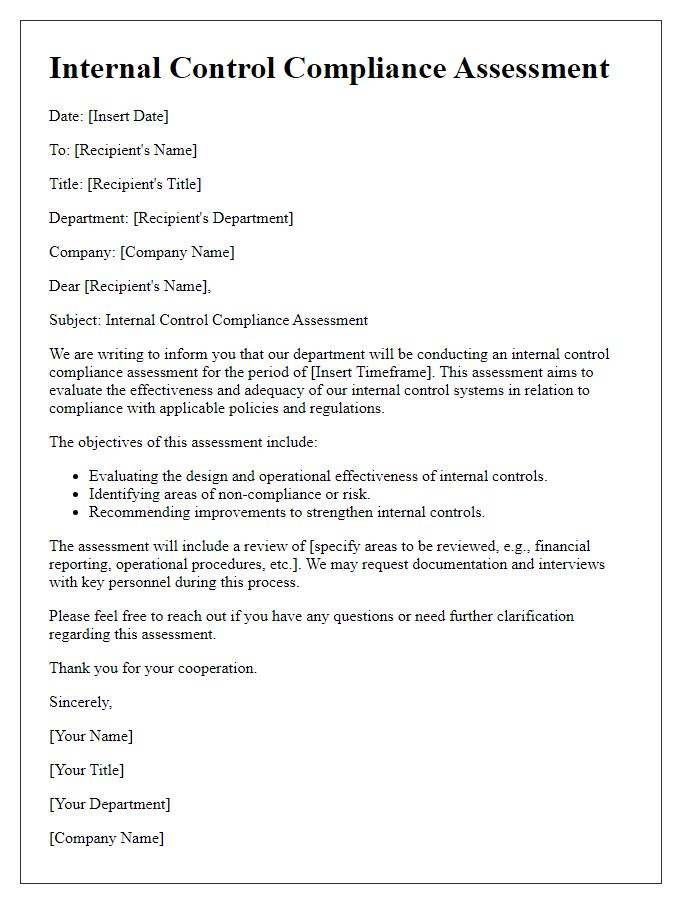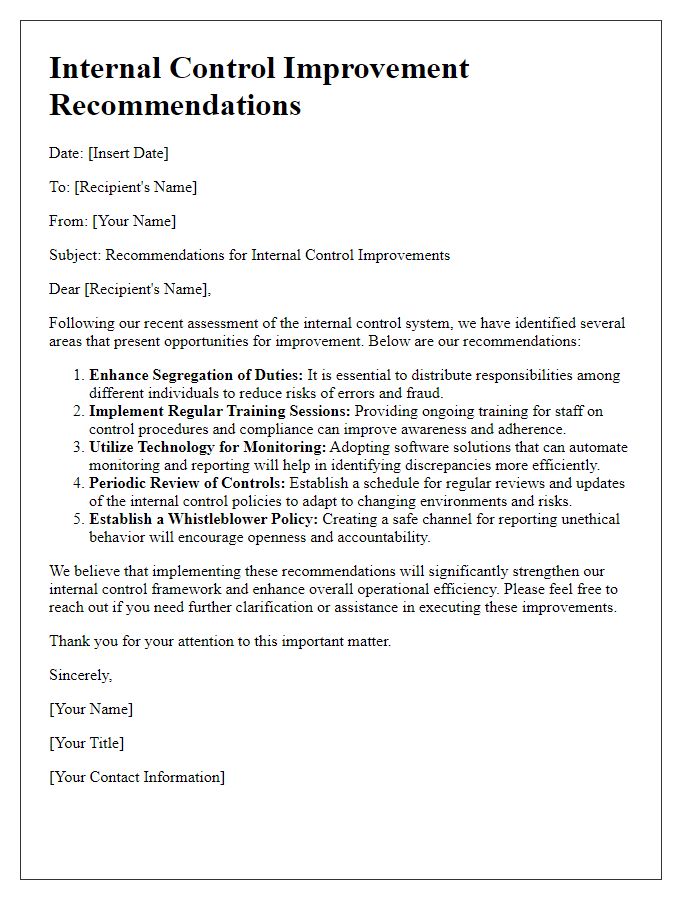Are you looking to enhance your organization's internal control systems? Crafting a comprehensive internal control assessment letter is a vital step in identifying potential weaknesses and ensuring compliance with regulations. This template serves as a guide to help you communicate effectively with stakeholders about your assessment process and findings. Dive in to discover how you can utilize this tool to strengthen your internal controls and boost organizational performance!

Alignment with Organizational Goals
Internal control assessments are essential in ensuring that an organization's operational processes align with its strategic objectives. These evaluations consider key factors such as compliance with policies, efficiency in resource utilization, and effectiveness in risk management. For example, the Sarbanes-Oxley Act of 2002 mandates that publicly traded companies in the United States implement rigorous internal controls to enhance the accuracy of financial reporting. A successful assessment examines specific goals, such as improving customer satisfaction by 20% within a fiscal year, or reducing operational costs by 15% by streamlining processes. Identifying discrepancies or gaps in these alignment efforts can significantly influence decision-making and promote improvements in accountability, transparency, and ethical behavior within the organization.
Identification of Key Risks
A thorough internal control assessment necessitates the identification of key risks that could impact organizational effectiveness and compliance. Common risks include financial misstatements, fraud susceptibility, operational inefficiencies, and regulatory non-compliance, particularly in sectors like finance and healthcare. For instance, financial misstatements can arise from revenue recognition errors, while fraud can occur in procurement processes, resulting in significant losses. Operational inefficiencies may be exacerbated by inadequate IT controls, leading to data breaches and loss of customer trust. Regulatory non-compliance, especially related to laws such as the Sarbanes-Oxley Act or HIPAA, can result in hefty fines and reputational damage. Mapping these risks to specific business units and processes enhances visibility and informs the development of targeted control activities.
Documentation of Control Activities
Control activities in an internal control assessment ensure that organizations meet objectives and mitigate risks effectively. These activities include various documented processes, such as segregation of duties, approval requirements, and transaction verifications. For instance, in a financial department, the approval process for expenditures often requires signatures from managers (usually two) to validate the expenses, promoting compliance with the budgetary controls. Additionally, documentation might involve using standardized forms for purchase requisitions or expense reports to facilitate accountability and traceability. Efficient control activities can also involve periodic reconciliations of financial statements to detect discrepancies promptly, thereby safeguarding assets and ensuring accurate reporting. A well-structured documentation process within these activities provides essential evidence that supports adherence to regulations, aiding in the overall assessment of risk management and operational efficiency.
Evaluation of Control Effectiveness
An internal control assessment evaluates the effectiveness of risk management strategies deployed within an organization, such as a financial institution. Such assessments often focus on critical areas, including operational processes, compliance with regulatory frameworks, like the Sarbanes-Oxley Act, and the accuracy of financial reporting. Specific criteria, such as the reliability of information systems and the safeguarding of assets, are analyzed using both qualitative and quantitative measures. Furthermore, findings may highlight deficiencies in controls related to revenue recognition or expense management, necessitating remedial actions. Effective internal controls are essential to mitigate risks such as fraud, ensuring that stakeholders maintain confidence in the integrity of financial statements.
Recommendations for Improvement
The internal control assessment process identifies various areas for enhancement within an organization's governance structure. Key recommendations for improvement often focus on critical components such as risk management frameworks, compliance monitoring systems, and operational efficiency metrics. Implementing standardized procedures for documentation ensures clarity in processes, as noted in organizations with compliance rates of over 90%. Increasing employee training programs, particularly those covering the latest regulatory requirements, can significantly reduce errors and enhance overall accountability. Additionally, adopting advanced technology solutions like automated auditing tools can streamline oversight functions, as businesses utilizing such technologies report up to 30% faster identification of discrepancies. Regular reviews of internal control procedures, at least annually, can mitigate risks and reinforce the integrity of financial reporting. Overall, these strategic improvements aim to bolster organizational resilience and maintain stakeholder trust.













Comments